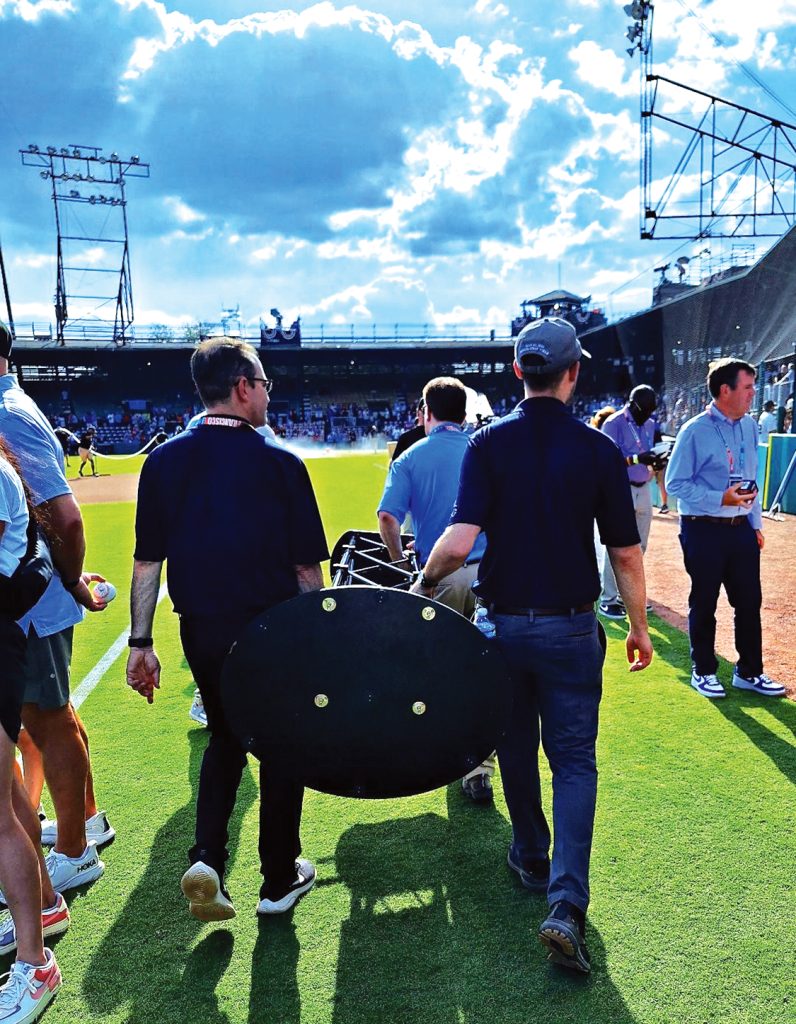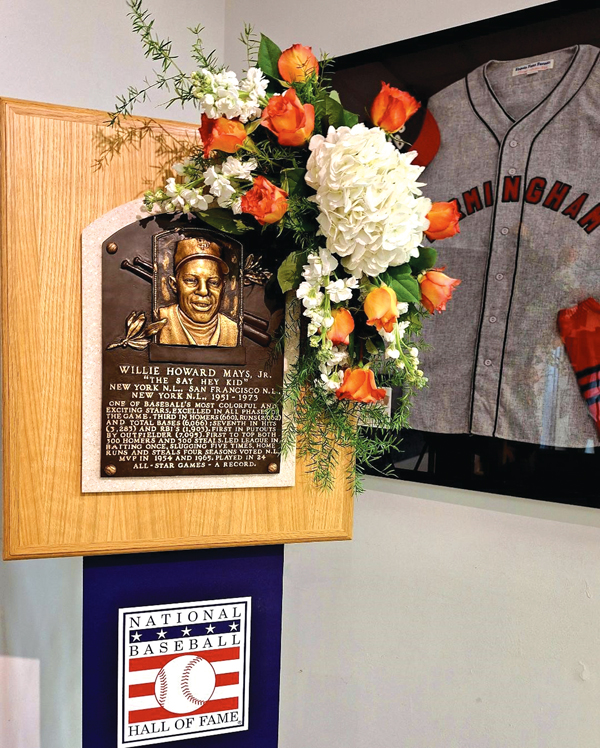
MLB at Rickwood, Negro League Tribute Serve as Center Stage for Farewell to MLB’s ‘Say Hey Kid’
HoF Officials On Hand as Baseball Mourns the Passing of Incomparable Willie Mays
By CHARLIE VASCELLARO
BIRMINGHAM, AL
The saying goes that baseball is a game without a clock, only innings, but time ran out on Willie Mays, 93, the game’s oldest living Hall of Famer, just as it was catching up with professional baseball’s Negro Leagues history in Mays’ birthplace of Birmingham, Alabama.
Fans in attendance (7,866) for the first day of a three-day celebration of Major League Baseball’s “A Tribute to the Negro Leagues” will never forget where they were when they heard the news.
Shortly after word began spreading via text messages and notifications during the seventh-inning stretch of the Double-A “Rickwood Classic” minor league contest between Montgomery and Birmingham on Tuesday, June 18, the public address announcer informed the crowd of Mays’ passing.
After the announcement, a highlight reel of classic Mays clips aired on the newly installed giant scoreboard behind the wall in right field, accompanied by “Say Hey (The Willie Mays Song),” the R&B baseball classic recorded by the Treniers in 1954.
We all sung along:
“Say hey, say who? Say Willie, Say hey, say who? Swinging at the plate
Say hey, say who? Say Willie That Giants kid is great.”
And the game went right on into the next inning. And Willie was gone. The game continues to move forward while Willie has been relegated to the past. Baseball’s tough that way. None of us get to live forever, not even Willie Mays.
Prior to the event, there was tremendous anticipation among the baseball community as to whether Mays would be on hand for the celebration. There was so much speculation that Mays issued a statement excusing his absence in advance on Monday, June 17, the day before three days of festivities culminating in the MLB at Rickwood regular-season game between Mays’ San Francisco Giants and the St. Louis Cardinals on Thursday, June 20.
“I wish I could come out to Rickwood Field this week to be with you all and enjoy that field with my friends. Rickwood’s been part of my life for all of my life. Since I was a kid. It was just ‘around the corner there’ from Fairfield [the town where Mays went to high school], and it felt like it had been there forever. Like a church. The first big thing I ever put my mind to was to play at Rickwood Field. It wasn’t a dream. It was something I was going to do. I was going to work hard to be one of the Birmingham Black Barons and play ball at Rickwood Field. That’s what I did. It was my start. My first job. You never forget that. Rickwood Field is where I played my first home game, and playing there was IT—everything I wanted. I’d like to be there, but I don’t move as well as I used to. So I’m going to watch from my home. But it will be good to see that. I’m glad that the Giants, Cardinals and MLB are doing this, letting everyone get to see pro ball at Rickwood Field. Good to remind people of all the great ball that has been played there, and all the players. All these years and it is still here. So am I. How about that?”
His written statement may well have been Mays’ last words to the public. His death provided the last word as to whether he would show up and kick started the celebration.

Even before Mays’ passing, a plan had already been in place for a contingent from Cooperstown—including Hall of Fame President Josh Rawitch, Vice President of Communications Jon Shestakofsky and Curator Tom Shieber, to bring Mays’ Hall of Fame plaque to Birmingham for festivities on the following Juneteenth afternoon.
“We drove from Cooperstown to Albany, where we were staying to take an early flight out Wednesday morning. And the news broke of Willie’s passing when we were driving from Cooperstown to Albany,” said Rawitch.
As Shestakofsky and Shieber carried the plaque horizontally while walking side-by-side, they almost looked like pall bearers. They may well have been delivering Mays’ headstone to his funeral.
“It can have a feel of looking that way [like a funeral], but I was just talking to Willie’s son, Michael, and he was saying this is more of a celebration, ‘My dad would have wanted us to be celebrating not mourning.’ I think it’s what Willie would have wanted. Willie would not want everyone being somber.”
The trio spent a lot of time carting the plaque around from place to place within the ballpark, using it as a backdrop for the MLB TV broadcasts and as a display in the various temporary museum installations created by Baltimore’s Canopy Team (founded by ballpark designer and urban planner Janet Marie Smith) for the event.
“What we bring with us is just the actual bronze piece [plaque] and what they were carrying was a very heavy wood backing. We shipped the whole stand with the wood backing. The only thing we brought from Cooperstown was just the bronze piece and then we put it on the wood backing when we got here, so it’s very heavy and so is the stand itself,” said Rawitch.
“We were able to fly with it. We never check it any time we do something like that—it’s obviously with us. We had it with us on the flight yesterday,” said Rawitch, adding, “It’s not light. The older ones from the 1979 era are heavier than they are now. So, it’s got some weight to it. It’s in a nice case. It’s not terribly hard to travel with. Anytime we take artifacts that are one-of-a-kind, whether it’s a plaque or even the stuff we’re taking tonight from tonight’s game, we will never check that. It’s always with us,” said Rawitch.
The three-day event was originally scheduled to be a remembrance and celebration of local Negro Leagues history within the larger context of Birmingham as a cradle of the Civil Rights movement, and birthplace of Mays, the city’s favorite son.
As word of Mays’ passing spread, it didn’t take long for the festivities to be converted into a three-day memorial celebration of his life.
There’s no clock in baseball, but there is time travel.
Fans that made the trip to Rickwood Field were transported back in time to the heydays of the Negro Leagues, encompassing the Roaring 20s, Depression-era 1930s and pre- and post-World War II 1940s. Major League Baseball recently incorporated the statistics of more than 2,300 Negro Leagues players from 1920-1948 into its historical record.
Bob Kendrick, president of the Negro Leagues Hall of Fame in Kansas City, has been at the forefront of raising consciousness about the history of Black professional baseball prior to Jackie Robinson breaking the color barrier and the integration of Major League Baseball in 1947. Kendrick was a visible spiritual presence throughout the three-day ceremony at Rickwood.
“All of this energy and excitement around the Negro Leagues has heightened the awareness to a level we have never seen before, and that’s something we had hoped we could do, but you’re never 100 percent sure that you can do it,” said Kendrick, adding, “I couldn’t be more excited. And when you come to a cathedral like Rickwood Field is, and then everything that has been done in preparation for this game, it’s almost impossible not to feel like you have time traveled. You feel like you have been moved back into the days when the Black Barons were playing in this stadium, and the look, the feel, the sound, the energy—it’s just been amazing.”
A bipartisan effort of Major League Baseball and the MLB Player’s Association, the event was primarily financed by the City of Birmingham, which ponied up $4.5 million for restoration, and renovation to the city-owned ballpark and event production. The three-day event was part of MLB and the Player’s Associations ongoing efforts to highlight both historic Black participation and future involvement in baseball. MLB and the Player’s Association made undisclosed contributions.
Only one Black player participated in the MLB at Rickwood game between the St. Louis Cardinals and San Francisco Giants; Cardinals shortstop Masyn Winn, who went 1-3 with a double and two runs scored in the Giants 6-5 victory.
An all-Black umpiring crew included Alan Porter (home plate) Adrian Johnson (first base), Malachi Moore (second base) and CB Bucknor (third base). All four umpires wore commemorative patches containing the initials “E.A.,” in honor of MLB’s first Black umpire Emmett Ashford, who is buried at Lakewood Cemetery in Cooperstown.
Mays’ passing hit the baseball community as hard as that of any one of the flurry of Hall of Famers who have passed in the last five years, including 10 that died between the 2019 and 2021 inductions (there was no induction in 2020).
The Say Hey Kid wore his enthusiasm and zest for life on his sleeve. He was the embodiment of our wonderful child-like selves. He seemed to always get away with it, making that basket catch we were all told not to try to imitate, because none of us could.
Willie Mays was one-of-kind.


Charlie, Not once did you mention “The Friends of Rickwood Field”.
We are the non profit who manage and care for the field.
Matter of fact it was our idea to reach out to MLB and ask them to come. Ask Jerri Dobbler about me.
Best,
Gerald Watkins Chairman, Friends of Rickwood Field